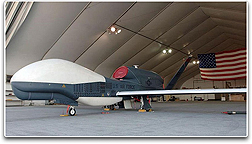From a Jung Sung-Ki bylined article in the online version of The Korea Times, the Korean Defense Acquisition Program Administration (DAPA) has selected Korean Air as the main developer of an indigenous, medium-altitude, unmanned aerial vehicle (UAV), which will be scheduled to start missions after 2016.
Korean Air, the country's largest airline, won the bid over
Korea Aerospace Industries (
KAI), which had previously dominated the country's military aircraft programs. The national-flag carrier, with the technological help of a foreign defense firm, will develop and integrate the spy plane's fuselage and other related systems, including a ground-control station and
mission equipment package (MEP), in cooperation with the state-run
Agency for Defense Development (ADD), said the article's source.
The proposed UAV will be designed to perform missions as high as 50,000 feet (some 15 kilometers) for more than 24 hours and will have similar specifications to the
MQ-1 Predator medium-altitude, long-endurance UAV of the
U.S. Air Force, ADD officials said. Approximately
450 billion won will be spent to build the surveillance aircraft. Korean Air's successful bidding was attributable to its better aircraft-making and system integration capabilities than those of KAI, said DAPA officials.

Earlier this year, the
Ministry of National Defense hinted that it would push harder for developing an indigenous UAV rather than purchasing the
Global Hawk high-flying UAV from the United States (
photo is of the Global Hawk). Senior ministry officials said that's because of budget constraints and also the
Lee Myung-bak administration's pursuit of cost-effective management of defense assets based on closer cooperation with the U.S. military. Seoul had sought to buy
Global Hawks by 2011 to strengthen independent intelligence, surveillance, and reconnaissance capabilities for the country's planned takeover of wartime operational control from the United States in 2012. The Global Hawk per-unit price is
$45 million to $60 million.


The South Korean military is largely dependent on U.S. intelligence, surveillance and reconnaissance (ISR) capabilities over North Korea.
U.S. Forces Korea operates several ISR systems, such as U2 reconnaissance and RC-12 surveillance aircraft (
see photo, left). The U.S.
KH-11 satellite (
see photo, right) is also a key system to help detect suspected activities in North Korea. The satellite can detect an on-land object as small as 15 centimeters in length.
South Korea's Air Force operates eight
Baekdu and
Geumgang reconnaissance planes, while the Army flies the domestically built
RQ-101 Night Intruder (
see photo, below) and Israel's
Searcher II UAVs with its frontline corps near the heavily fortified border with the North.

Topical Tags :
Regional Tags :

